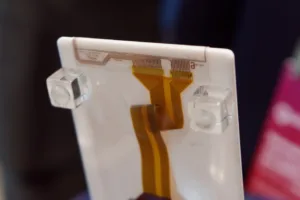 Atmel showed this automotive demo at PepcomTouch controller maker, Atmel, was at the Pepcom event and was talking about its latest developments. The company is making its touch technology more sensitive as there are more and more customers that are now looking for hover as well as touch functions. There was a new demonstration of an automotive touch-enabled console.
Atmel showed this automotive demo at PepcomTouch controller maker, Atmel, was at the Pepcom event and was talking about its latest developments. The company is making its touch technology more sensitive as there are more and more customers that are now looking for hover as well as touch functions. There was a new demonstration of an automotive touch-enabled console.
Atmel has been developing new chips for wearables and smartwatches. These need to work with touch even where users have gloves on or where moisture may be a problem and they also have to support these functions, but with continuing cost and power reductions. Atmel told us that it has design wins in the Moto 360 and Xiaomi wearables.
The firm was also emphasising that it has a new debugging system for its controllers. Procap touch systems need quite a lot of tuning, which can make them harder to use in low volume applications (such as machine control) because of the time and cost of the setup. The new software means that 70% of the system parameters can be set in just two hours, Atmel claims.
Later, in the company’s suite, we saw some new copper sensors that can get resistance down to 10Ω/sq and allow high resolution displays up to 446ppi. The pattern of the touch sensor can be optimised for the pixel structure to avoid moiré patterns caused by interference between the pattern on the touch sensor and the pixel structure.
Copper is, of course, much more flexible than ITO, so the sensor can actually be bent over the ends of the display so that very narrow borders are possible. Atmel has also done a lot of work to replace the bonded tabs that are normally connected to the sensor. The company can supply sensors with integrated tails.
Also on display was some very low power procap touch technology that can run dual touch from as little as 4μA for dual touch detection at 100Hz using just 10% of the power of a typical AP. At the moment, the maximum size is 5.5″ and the technology has not yet been put on a display, but Atmel told us that there is a “lot” of interest in moving it to displays. “It’s the first question everybody asks!”, we heard.
Atmel’s flexible touch sensor will wrap around the end of a phone display

